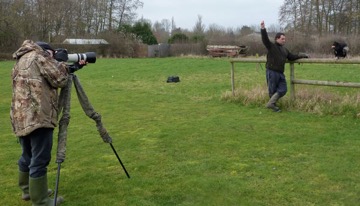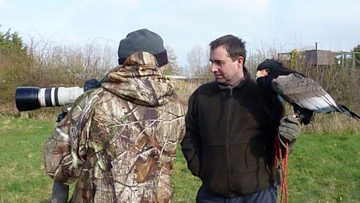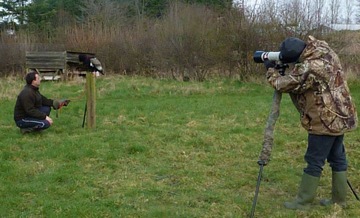Last year we were really delighted with our rehabilitation rate of 48% of the injured birds that came in to the Sanctuary hospital. It is, however, a sad fact that a large number of the injuries we see to wild birds of prey are caused by road traffic accidents. There isn’t always a lot that can be done for a bird which has shattered bones after either colliding with a vehicle or being smashed into the road via the downdraft of a speeding truck and sadly the kindest thing to do is to ask our vet to relieve them from their suffering.
Volunteer Steve tenderly holds the injured bird as Andy administers some remedial eyedrops followed by some hand-fed nourishment
Sometimes though, luck is on the bird’s side - as was the case with a Little Owl found by a member of the public at the side of the road last week. Fortunately, close examination by one of our dedicated falconry team revealed no broken bones but the poor owl did have extensive facial bruising and both eyes were swollen completely shut. It seems most likely that the unfortunate bird had been caught up in the slip-stream of a vehicle, rather than being involved in a collision. Owls in particular can be pretty unstable in flight in windy conditions. Owl feathers are designed to have a lot of movement in them, enabling the owl to fly completely silently and thereby catching their prey by surprise. Unfortunately this does mean they are easily caught out by a gust of wind or the draught caused by a passing vehicle. This Little Owl’s injuries suggested that it had probably hit the ground fairly hard, hence the bruising and swelling.
Battered & bruised - but not defeated. This Little Owl should live to tell the tale
A visit to our supporting vet confirmed the diagnosis and the Little Owl is now on a course of antibiotics and also eye-drops, which will need to be administered for an undetermined length of time.
This is one reason why our supporters’ donations and adoptions are so important to us; they enable us to continue to deliver the care & treatment that our hospital residents so badly need. We are very grateful indeed for everyone’s continued help and support.
Fortunately, regular volunteer Steve has been on hand to help Andy administer the medication – definitely not a one person job when you’re dealing with a wild animal. Despite their size, Little Owls can be really feisty and their tiny talons especially sharp!
It’s now just over a week since the little chap (chapess?) was brought into the Sanctuary and I’m very pleased to report that s/he is doing really well. One eye is now open and everything is looking far less bruised and swollen. The falconers are confident that, barring unforseen complications, this Little Owl will make a full recovery - so I really look forward to being able to report on its release!



























































